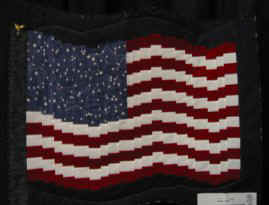
One of the many quilts displayed at the 2002 Roswell Quilt Show September 27, 28 and 29, this one made by Kerry Beason of Roswell is called “Fractured Flag.”
ROSWELL — THE ALL AMERICA CITY
essay by Daniel Pacheco,
Roswell High School 9th grade student
On September 25, 2002, Roswell as a city showed its patriotism by flocking to the Wool Bowl. The “heroes” in our great city were honored this memorable evening. We, as Roswell citizens and as Americans, showed our support to the victims of the September 11, 2001 crisis by gathering at the Wool Bowl.
Roswell as a city stood up for what we believe in, our country. Although we were maliciously attacked on the horrific day of September 11, 2001, it made Americans stronger, by means of standing up for our country and setting examples for other countries in how America is really united. It made Americans realize what we have, like our family, and cherish them. September 11 changed Americans critically!
The Roswell High and Goddard Bands and Chorus were in attendance at the event, along with the “heroes” who serve each day risking their lives for the safety of us, the citizens. Pastors of various churches were also present at this event. This rally showed me that Roswell is an All American City! Although the Twin Towers weren’t in Roswell, or even in New Mexico, we remembered them because this tragedy affected every American.
I thank everyone for attending this rally. It was very supportive of everyone who showed up honoring our loved city, Roswell, and our treasured and unique country, the Mighty United States of America.
Let’s Roll!
RWM asked Daniel Pacheco, author of the above, to send his bio. Here it is: Daniel Pacheco is a beginning 9th grader at Roswell High. He attended Mesa Middle School for both 7th and 8th grade years.
Daniel wrote: “In 7th grade, my English teacher was the great Heidi Huckabee! We did the Cemetery Project Book, which had a great outcome. In 8th grade, I went into Honors English also with Mrs. Huckabee. Her class was difficult at times, but each moment, she made it fun and interesting. I always thought I couldn’t write extremely well, but all it takes is practice. She has shown me so much. I also did a few oratorical contests with her. I also did one for MESA Club (Mathematics Engineering Science Achievement Club) with two other classmates and we received first in state.
At Roswell High School, I am taking Honors English with Mr. Kelt. Again, this class is challenging, but more relaxed than middle school; it still requires English skills and thinking. I hope one day to become a counselor like my role model, Ms. (Mary Frances) Laumbach, or a middle school teacher or city mayor.”
The brochure, Walking Through Roswell’s Past, a Self-Guided Historical Walking Tour of Roswell’s South Park Cemetery (which can be found at the Roswell Convention and Civic Center), and the book, South Park Cemetery: Exploring Roswell’s Roots (which can be purchased at Roswell’s Mesa Middle School) is the project mentioned by Daniel.
A few months ago, Daniel wrote an Email to the editor of RWM after he saw an extensive piece written about Mary Frances Laumbach (Archives, issue 6). He said he hoped Roswell Web Magazine would accept student submissions. He recently submitted the above essay for publication. Roswell Web Magazine salutes Daniel Pacheco and we hope to meet him one day.
Roswell Rallies for America, commemorating the one-year anniversary of the terrorist attack on America, was scheduled for September 11, but torrential rains caused a postponement. It was rescheduled for Wednesday night, September 25. The community gathered in the Wool Bowl to honor the victims and their families, and the heroes who risked their lives to save others on 9-11. Roswell also honored their own public safety employees who daily risk their lives to keep us safe and free. The event included fireworks, music, talks, a proclamation by Mayor Bill Owen, and sport-parachute jumper, Glenn West, who jumped out of a plane piloted by Magistrate Judge Robert Corn. RWM
====================================
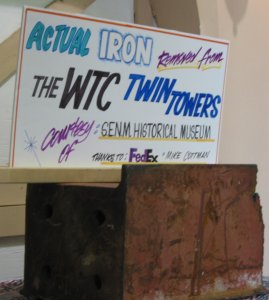
A piece of an I-beam from the wreckage of New York’s World Trade Center Twin Towers, on display by the Roswell Fire Department at the Eastern New Mexico State Fair in Roswell. Following the fair, it will be permanently housed by the Southeast New Mexico Historical Museum.
***
The following, received by Email on September 11, 2002, was supposedly written by a dentist in Australia.
AN AMERICAN
You probably missed it in the rush of news last week, but there was a report that someone in Pakistan published in a newspaper an offer of a reward to anyone who killed an American, any American. So I just thought I would write to let them know what an American is, so they would know when they found one.
An American is English, or French, or Italian, Irish, German, Spanish, Polish, Russian or Greek. An American may also be Canadian, Mexican, African, Indian, Chinese, Japanese, Australian, Iranian, Asian, Arab, or Pakistani or Afghan. An American may also be a Cherokee, Osage, Blackfoot, Navaho, Apache, or one of the many other tribes known as native Americans.
An American is Christian, or he could be Jewish, or Buddhist, or Muslim. In fact, there are more Muslims in American than in Afganistan, The only difference is that in America, they are free to worship as each of them chooses. an American is also free to believe in no religion. For that, he will answer only to God, not to the government, or to armed thugs claiming to speak for the government or God.
An American is from the most prosperous land in the history of the world. The root of that prosperity can be found in the Declaration of Independence, which recognizes the God-given right of each man and woman to the pursuit of happiness.
An American is generous. Americans have helped just about every other nation in the world in their time of need. When Afganistan was overrun by the Soviet Army 20 years ago, Americans went with arms and supplies to enable the people to win back their country. As of the morning of September 11, Americans had given more than any other nation to the poor in Afganistan.
Americans welcome the best — the best products, the best books, the best music, the best food, the best athletes. But they also welcome the least. The national symbol of America, the Statue of Liberty, welcomes your tired, and your poor, the wretched refuse of your teeming shores, the homeless, tempest tossed. Those, in fact, are the people who built America. Some of them were working in the Twin Towers the morning of September 11, earning a better life for their families. I’ve been told the World Trade Center victims were from at least 30 other countries, cultures and first languages, including those that aided and abetted the terrorists.
So — you can try to kill an American. Hitler did. so did General Tojo, and Stalin, and Mao Tse-Tung, and every bloodthirsty tyrant in the history of the world. But in doing so, you would only be killing yourself. Because Americans are not a particular people from a particular place. They are the embodiment of the human spirit of freedom. Everyone who hold that spirit, everywhere, is an American.
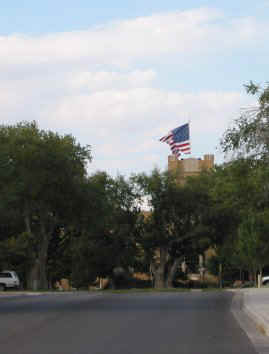
Long may she wave: The flag flies over the battlements of the New Mexico Military Institute, as seen from Richardson at College, in Roswell
====================================

(Above photo taken a few hours after area’s only snowfall of the year, January 1, 2002)
Heading to Leprino during the Chile Cheese Festival September 27, 2002, one of the bus tour guides, Will Cass of Eastern New Mexico Liberal Arts Department, said, as the bus passed the historical Chaves County Court House: “The first courthouse was built in 1890 and torn down in 1910. The present day courthouse was completed in 1911 at a cost of $164,000 and was dedicated in 1912, the same month (and year) New Mexico became a state. There was an execution by hanging on the southeast corner of the courthouse in the early 1900s. The courthouse is now on the National Register of Historic Places. In 2000, our courthouse was voted one of the most beautiful historic buildings in the state of New Mexico.”
(The script used by the tour guides, on the busses to Leprino, was written by Dusty Huckabee, director of MainStreet Roswell and coordinator of the Chile Cheese Festival. The bus your editor rode was a refurbished MC-8, manufactured at Transportation Manufacturing Corporation south of Roswell in 1978. TMC was Roswell’s first, as well as its largest and longest-lived coach and bus manufacturing plant. )
ROSWELL’S FALL FESTIVALS
The second annual Dragonfly Festival was held September 14 and 15, with events from sunup to sundown at the Bitter Lake National Wildlife Refuge. (For more information and photos about the Refuge and the Festival, see the Byways Page of this issue.)
That same weekend was the Pinatafest Cultural Celebration at Poe Corn Park — titled “To Honor, to Heal to Remember,” dedicated to the tragedies of 9-11 and also Roswell’s own tragedy of March 6 when the community’s Fire Chief, an Emergency Medical Technician and a neighbor, who was a city employee, were killed and a child severely injured, when they went to the aid of a fire victim. The event also remembered two State Police officers of Roswell who were killed in a helicopter crash a few months earlier.
The Pinatafest, sponsored by Hispano Chamber of Commerce, included booths filled with good things to eat and wear, a car show, fiesta dancers, mariachi and other types of Hispanic music by local musicians, and an open-air Mariachi Mass celebrated by Archbishop Ricardo Ramirez of Las Cruces.
On September 27 and 28, MainStreet Roswell presented their 10th annual Chile Cheese Festival, and along with it, the 2002 Roswell Quilt Show. These, including many booths and live entertainment, were held inside and outside of the Roswell Convention and Civic Center. Included with the Chile Cheese Festival was a guided tour, by bus, of Leprino Foods cheese production factory, located south of Roswell. This factory is the world’s largest mozzarella cheese production plant. (No cameras, notebooks, etc. were allowed inside Leprino.)
The Chile Cheese Festival recognized farmers and ranchers of Chaves County, the state’s largest agriculture producer.

In Chaves County, 4,900 cultivated acres of chile generated $1,500,000 to the economy in 2001.
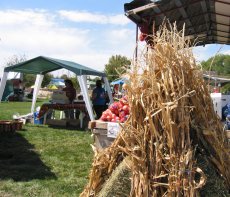
In Chaves County, 55,000 acres of hay, 4,400 acres of cotton, 13,100 acres of corn and sorgum (feed), 3,131 acres of pecan trees, and 1,000 acres of other vegetables are grown. Crops and livestock, which include the many dairy cattle, beef cattle and sheep, generate $949,800,000 to the economy of Chaves County.
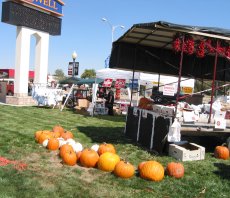
The Horse Whisperer
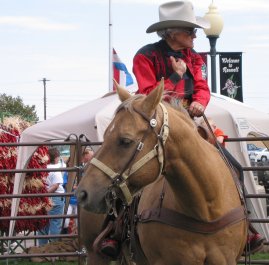
Suzanne Jones, horse breeder and trainer, demonstrated techniques she uses to communicate with her horse. Her demonstrations showed her horse’s agility as well her ability to convey signals to her horse without rein, bridle or rope.
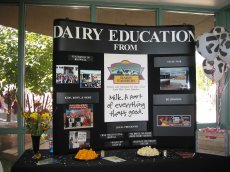
With its many dairies, Chaves County produced 1,618,406,357 pounds of milk in 2001, with an economic impact of $500,249,400.
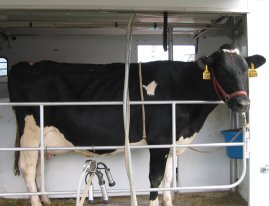
Friday the cow was “on stage” in the mobile dairy classroom on Saturday illustrating the modern process of milking cows, the characteristics and anatomy of dairy cows, and the importance of dairy foods in a healthy diet. Children and adults learned that cows have four stomachs, and it takes two days for milk to get from inside the cow to the grocery store without ever being touched by human hands. One average cow produces nearly 200,000 glasses of milk during her lifetime. From milk comes many products, including more than 2,000 kinds of cheese.
In number of dairies, New Mexico ranks among the top 10 states in the nation, 8th in milk production and in cheese production, and 5th in the average annual milk production per cow at 20,500 pounds in 2001. New Mexico had 17 milk process plants — including Roswell’s Leprino and Nature’s Dairy, and three at Dexter and Lake Arthur — at the end of 2001. Nearly half of New Mexico’s milk went into the manufacture of cheese. As of end of 2001, There were 39 dairies in Chaves County, 40 in neighboring Roosevelt; 16 in Lea, 7 in Eddy, and 1 in Lincoln.
Although it is called the 2002 Roswell Quilt Show, exhibitors submitted 246 pieces from all over New Mexico and west Texas. They displayed their needlecraft as well as their artistic ability to the public, and most competed in the show.
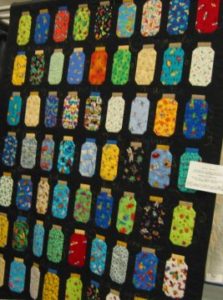
“Bugs in a Bottle” by Jean McDonald of Roswell
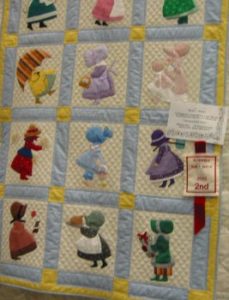
“Sun Bonnet Sue” by Vi Perkowski of Roswell
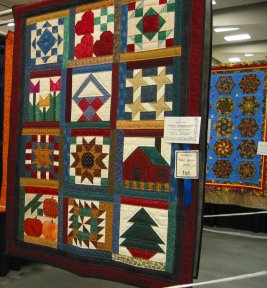
“Thimbleberries Village” by Bette Bossell of Roswell
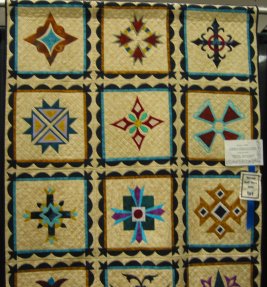
“Las Cruces” by Bette Bossell of Roswell
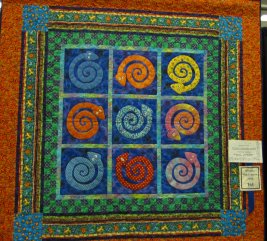
“Swirley Snakes” by Edith Stanton of Artesia
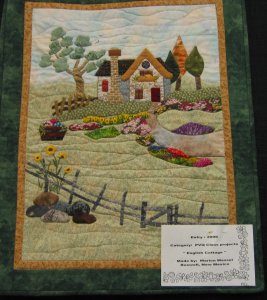
“English Cottage: by Marion Wessel of Roswell
A QUILTER’S POEM
by Joyce Abrahamson
Just as a quilter puts together fabric,
piece by piece creating a design,
a poet joins her thoughts into couplet,
word by word ’till they become a rhyme.
The beauty of the quilt brings visual pleasure,
with each joined piece a pattern does appear,
as with words joined in melodic measure
brings the poem’s beauty to your ear.
Poetry and quilts are made from segments,
joined with harmony to make the whole,
piece by piece and word by word, the fragments
create a work of art that’s from the soul.
While scraps of cloth or scraps of words are blending,
beauty from the heart is never ending.
On Monday, September 30, began the week-long 2002 Eastern New Mexico State Fair, the oldest fair in New Mexico, which began 80 years ago, in 1922.
The words below, describing the earlier fairs in Roswell, were spoken by the tour guides, in period costume, on the buses that took visitors to the guided tour of the Leprino plant. The script was written by Dusty Huckabee, director of MainStreet Roswell and festival coordinator. Dusty said much of his historical information came from Elvis Fleming.
“Roswell has the distinction of hosting the first harvest fair in the state of New Mexico. In the early days, it was held behind (what is now) the Unity Center on West Colelge Street. Local farmers would build a huge castle made of hay bales and this is where they displayed their prime agriculture products as well as quilts, baked goods, and garden flower displays.
Another unique thing about that harvest fair was you could get there by river boat. That’s right, you would go to the present day Cahoon Park swimming pool and board the boat and meander through what is now Spring River Golf Course and end up at the fair.
The harvest fair later moved across from the (present location of the) Convention Center, next to (where is now) Cattle Baron’s. There are photos of an early Ferris wheel powered by oxen walking in a circle turning a crank that linked a big belt to the Ferris wheel, causing the wheel to turn.”
Here are a few early glimpses of the ENM Fair:
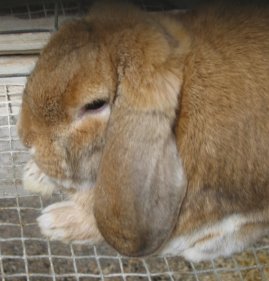
This mini-lop, owned by Andrea Voz, won best of breed
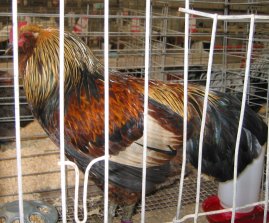
This beauty, owned by Shadoe Dawn Petty, is called a Standard American
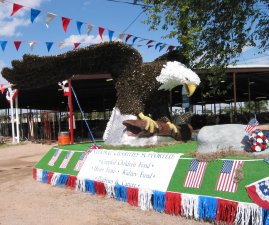
This American bird is a winner anywhere he goes
BILLY MATHEWS
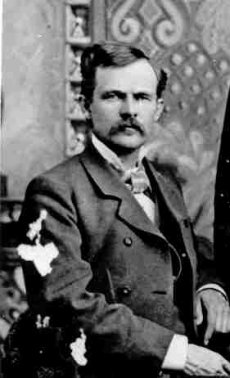
When Elvis E. Fleming’s book, J.B. “BILLY” MATHEWS: BIOGRAPHY OF A LINCOLN COUNTY DEPUTY (published by Yucca Tree Press, 1999) became available, he gave a talk for the Lincoln County Historical Society about him. Lynda Sanchez wanted Fleming to sing, so he wrote this song (words and music) about Billy in October 1999.
THE BALLAD OF BILLY MATHEWS
1. Now, this is the Ballad of Billy Mathews,
A miner, a cowboy, a gunfighter too;
to Old Lincoln County in time he did go,
to make his place in the hist’ry of New Mexico.
Now Jimmy Dolan, he needed a hand,
that’s how Billy Mathews was his right-hand man.
A-clerkin’, a’riding,’ or working for right,
Billy Mathews as always there ready to fight.
Oh, where do you ride? Oh where do you ride?
Oh where do you ride, Billy Mathews, tonight?
2. The trouble it started in ‘seventy-eight,
A most important historical date,
for Murphy-Dolan and Tunstall-McSween,
more killin’ and fightin’ than Lincoln had seen.
The sheriff sent Mathews to John Tunstall’s spread,
with a posse to seize McSween’s cattle for debt.
But John Henry Tunstall resisted the law
and his death, then, it started the Lincoln County War.
Oh, where do you ride? Oh where do you ride?
Oh where do you ride, Billy Mathews, tonight?
3. Now William H. Bonney was the scourge of the town,
he waylaid the sheriff, shot Billy Brady down.
But Billy Mathews escaped getting hit
and put a slug through the leg of young Billy the Kid.
The big Five-Day Battle took place in July,
This time it was Alex McSween’s turn to die.
Billy Mathews was one of the sheriff’s men there
in the climactic battle that ended the war.
Oh, where do you ride? Oh Where do you ride?
Oh where do you ride, Billy Mathews tonight?
4. The outlaws in Lincoln then had a hey-day.
The solution it was up to President Hayes,
he sent a new governor and new federal men
to get New Mexico on track again.
Pat Garrett was chosen to hunt the Kid down,
he went to Fort Sumner where the Kid hung around.
The outlaws were captured at old Stinking Springs,
And ended the rustling’ and their killin’g fling.
Oh, where do you ride? Where do you ride?
Oh where do you ride, Billy Mathews tonight?
5. The Kid, to Mesilla was taken for trial,
for killing the sheriff, a murder so vile;
Billy Mathews did testify against the Kid.
The courthouse in Lincoln could not hold the Kid,
He shot down his guards and for freedom he bid.
Went looking for Mathews, but he ran out of hope,
He was shot at Fort Sumner and cheated the rope.
Oh, where do you ride? Where do you ride?
Oh where do you ride Billy Mathews tonight?
6. Billy Mathews left town after the Lincoln County War,
To the Penasco Valley and the ranch C-A Bar.
The ’93 Panic could not get him down;
he became the postmaster of old Roswell town.
Now you’ve heard the Ballad of Billy Mathews,
a miner, a cowboy, a gunfighter, too;
to Old Lincoln County in time he did go
and made his place in the hist’ry of New Mexico.
Oh where do you ride? Where do you ride?
Where do you ride, Billy Mathews tonight?
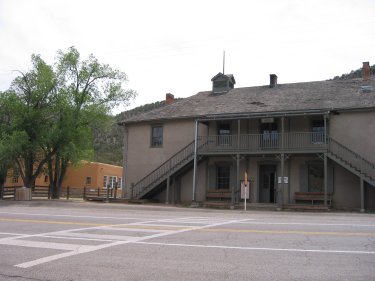
The Old Lincoln County Courthouse where William H. “Billy the Kid” Bonney made his last escape April 28, 1881.
Jean Willis, Court Administrator for the Chaves County Court, recently came across an interesting old letter. What was the most interesting was the letterhead:
“KING TOWNSITE COMPANY
Centrally located in the best portion of East Chaves County, surrounded by a dense population and with a powerful water supply. We not only claim a live town, but a coming city.”
Printed across the top of the letterhead are: G.G. Jones, President, Henry Hobbs, Treasurer, and James F. Denton, Secretary. Printed also, beside the date, is King, New Mexico. The handwritten letter, dated Jan. 9, 1910, was written and signed by James F. Denton and addressed to R.F. Ballard of Roswell, a county or community official.
The description of an existing population and a powerful water supply makes you think of the Roswell area when artesian wells were still plentiful and producing an abundance of water.
Upon being asked about the location and any information about a place once known as King, New Mexico, Elvis F. Fleming, city historian and archivist for Historical Society for New Mexico, said:
“Keep in mind that Chaves County went all the way eastward to the Texas line from 1889 until 1917. According to Bob Julyan’s book, The Place Names of New Mexico, King was in present Lea County, 10 miles southeast of present Tatum. There was a post office there from 1909 until 1918. It took the name of the family who settled it and got the office. At one time, it had stores, a school and a weekly newspaper called The King of Progress.”
Areas of New Mexico and other sparsely populated places of the southwest were often settings of romanticized or exaggerated promotions for new townsites during that era. Fleming added, “Unfortunately, most of them tried to start towns or farms during the wet cycle. When the rains failed to come, they fizzled.”
Joseph C. Lea: From Confederate Guerrilla to New Mexico Patriarch, the book by Elvis E. Fleming, is available at the Historical Society for Southeast New Mexico, 200 N. Lea Avenue, and also at Cobean’s Stationery, 320 N. Richardson Avenue, Roswell. The book sells for $25, with over 260 pages plus 66 illustrations. It was published by Yucca Tree Press in Las Cruces, in cooperation with, and to benefit, the HSSNM.
The author, Fleming, is city historian, member of and archivist for Historical Society for New Mexico, as well as Eastern New Mexico University-Roswell professor of history, emeritus.
Rwm
 Roswell Web Magazine
Roswell Web Magazine